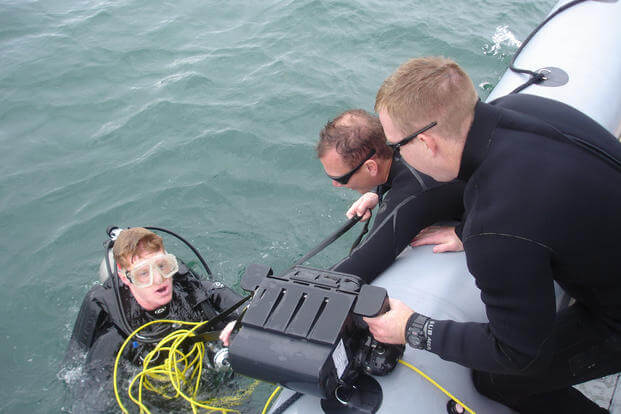Navy Explosive Ordnance Disposal (EOD) and Navy diver are two separate professions within the Navy Special Operations community; however, if you are Navy EOD, you also will be Navy EOD Diver qualified. Navy EOD works closely with the Special Operations Command (SOCOM) and is classified as Navy Special Operations.
Naval Special Operations:
EOD (Navy Diving and Explosives Ordnance Disposal) dismantles and renders safe unexploded ordnance to include underwater mines, landmines and IEDs (improvised explosive devices).
Navy EOD personnel are experts in explosives, diving, parachuting and possess the tactical skills of a combat fighter. The men and women of Navy EOD are capable of rendering safe all types of explosives to include conventional, improvised, underwater, chemical, biological and nuclear.
Navy EOD personnel are tasked to work with elite units within SOCOM, federal law enforcement, Secret Service, the Department of Homeland Security and foreign allies. EOD units military-wide are also experts in post-blast investigation, using intelligence to create bombmaker folders with respect to IEDs in areas where U.S. and Allied troops fight.
Clarification: Navy EOD is not under the command of U.S. Special Operations Command (unlike Navy SEAL & SWCC). However, EOD is considered to be part of the Naval Special Operations community.
Pre-recruiter: Do you qualify?
Recruits must have the following qualifications to be considered for Navy EOD:
- Below 31 years old
- Pass the dive medical physical exam/pressure test
- Vision must be 20/200 (correctable to 20/20)
- No color blindness
- Must be U.S. citizens
- One full year without non-judicial judgments
- Score on the ASVAB: 110 (combined AR and VE) or 165 (combined GS, MC and EI)
- Pass the Navy SEAL/SWCC/EOD/diver PST
Below are the steps required to becoming an enlisted member of the Navy Special Operations community:
Step 1: Choose a Spec Ops source rating
Go to a recruiter's office. You will have to sign up for a regular Navy source rating to join the Delayed Entry Program. However, once you pass the standards of the Navy EOD physical screening test (PST), you will be given a new designation. The new ratings are the following:
EOD: (EOD)
Ask your local recruiter about the Navy Special Warfare/Special Operations mentor in your area. These former SEAL, EOD and divers are mentors for recruits, and their duties are to help recruits prepare for training by giving regularly scheduled PSTs.
Step 2: Boot-camp training
All recruits will report to Great Lakes, Illinois, to attend basic military training. During boot camp, you will be required to pass the Special Warfare/Operations PST again. If you pass at boot camp, you are officially in the pre-training community, meaning you will get orders to the Navy EOD and Diving Schools.
Step 3: Pre-training
Your job is to learn about the Special Operations community, as well as start an extensive physical training program for 3-4 weeks after boot camp in Great Lakes. The pre-training program is to help candidates get into better shape, as boot camp does not prepare a SEAL, EOD tech or diver properly for their advanced training programs. However, to ace the PST at boot camp, you need to be in top shape before Boot Camp; otherwise, you easily can fail this challenging fitness test.
The pre-training instructors are not interested in weeding anyone out at this point. The goal is to teach candidates that they will not survive the next phase of training if they strive for the minimum standards in the PST. Below are the minimum and recommended standards for the PST and success in these programs:
| PST Event | Minimum Standards | Competitive Standards |
| 500-yard swim | 12:30 | 9 minutes |
| Push-ups | 50 | 80-100 |
| Sit-ups | 50 | 80-100 |
| Pull-ups | 6 | 15-20 |
| 1.5-mile timed run | 12:00 | 9-10 minutes |
The minimum standards will only get you into the program so you can train with your mentor prior to boot camp. You still have to show up to boot camp in above-average shape, and it is recommended that you should hit all of the above recommended scores prior to boot camp to ensure a proper physical foundation.
Step 4: Training cycle
Basic Navy EOD Dive School: Nine weeks of diving training in Panama City, Florida, where EOD candidates will learn basic diving as well as advanced rebreather diving using the Mk16 rebreather system.
Basic EOD training: 42 weeks, Joint Service EOD School at Eglin Air Force Base, Florida. All military services attend this EOD training program after military personnel have passed their branch's basic and advanced training programs within their service's EOD community. The Navy EOD will have an extra school, compared to the other branches. They will focus on underwater explosives such as torpedoes, unexploded underwater ordnance and underwater search techniques.
Basic parachute training. Three weeks at Fort Benning, Georgia, at the Army's Basic Airborne Course, where students will learn static-line parachute skills.
EOD tactical training: The final three weeks are spent in Coronado, California, where EOD students will learn tactical skills needed to deploy with Navy SEALs, Army Special Forces and Special Operations Forces.
Other EOD branches in the military: Army, Air Force, Marine and other government entities involved in EOD (bomb squads) attend a Joint Training Command, Navy-operated EOD school on Eglin AFB.
Stew Smith is a former Navy SEAL and fitness author certified as a Strength and Conditioning Specialist (CSCS) with the National Strength and Conditioning Association. Visit his Fitness eBook store if you're looking to start a workout program to create a healthy lifestyle. Send your fitness questions to stew@stewsmith.com.
Want to Learn More About Military Life?
Whether you're thinking of joining the military, looking for fitness and basic training tips, or keeping up with military life and benefits, Military.com has you covered. Subscribe to Military.com to have military news, updates and resources delivered directly to your inbox.



















